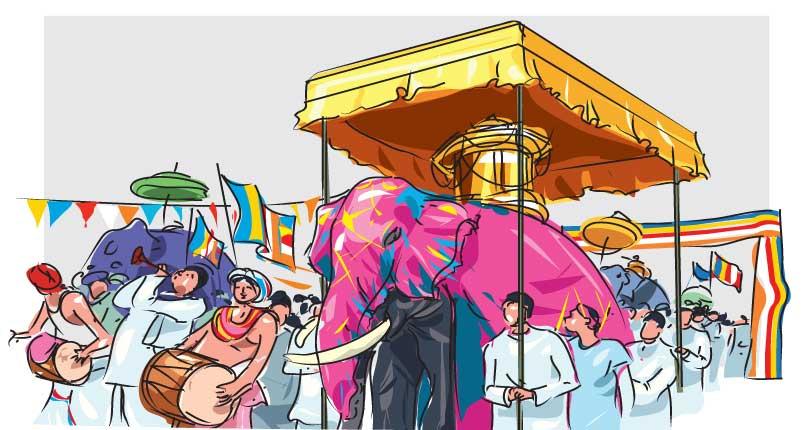Reply To:
Name - Reply Comment

In the wake of Britain’s colonization of Sri Lanka then known as Ceylon came to be popular the world over as the producer of the world-famous Ceylon Tea. But from time immemorial, Sri Lanka was at various times described as Taprobane, Thambapane and prompted by its shape, as the Pearl of the Indian Ocean or the Tea Drop Island and the land of the Esala Perahera, which was watched annually by tens of thousands of Sri Lankans and foreign tourists.
It was only a week ago, on Wednesday August 15 that we saw the conclusion of the Kandy Esala Perahera held under the patronage of the Dalada Maligawa or the Temple of the Tooth. The festival is customarily held in the month of Esala, beginning on Esala Poya in July and ending on Nikini Poya in August.
The Esala Perahera is one of the oldest and grandest of all Buddhist festivals in Sri Lanka and underpins the country’s culture, traditions and religious fervour. The month of Esala is when Sri Lankan Buddhists commemorate the first sermon delivered by the Buddha after attaining enlightenment and is also a way of honouring the Sacred Tooth Relic and the four ‘guardian’ Gods and Goddesses of Natha, Vishnu, Kataragama and Pattini. The main Perahera featuring dancers, jugglers, musicians, fire-breathers and lavishly caparisoned elephants including several tuskers is followed by those of the four Devales, which are situated in the vicinity of the Temple of the Tooth.
History records that it was after the Kandyan Kingdom fell to the British in 1815 that the custody of the Tooth Relic came to be handed over to the Buddhist Clergy and in the absence of the King, a lay custodian called the Diyawadana Nilame was appointed to handle routine administrative matters. The Kandy Esala Perahera, considered to be one of the most picturesque pageants in Asia parades the streets of Kandy with pomp and pageantry carrying the sacred tooth relic of the Buddha while beseeching the gods to sprinkle this land with rain and bless it with fertile soil, the essential ingredients for a bountiful harvest. Like in past years, this year too, thousands upon thousands -- for some an experience of a lifetime -- wended their way to the historic city of Kandy and lined the streets of the Perahera, night after night, to imbibe in the country’s culture, age-old traditions, religious rituals and observances.
The ritual known as ‘Kap Situweema’ or the planting of a sanctified Jackfruit sapling on August 1 at the auspicious time selected by astrologers heralded the start of the Perahera festivities. The sapling is sprinkled with sandalwood-scented water with offerings made of nine kinds of flowers and an oil lamp with nine wicks while the priest of the Maha Vishnu Devale or the Vishnu Temple offered prayers to all the gods and goddesses.
The writings left behind by Robert Knox and John Davy provide much evidence as to the organization and evolution of the present day perahera with many features being added and some changed to suit the times and the available resources. The Dalada Perahera and social traditions are linked with the lunar month of Esala in July/August, so much so that it has been named the Perahera month with the centrepeice being the Esala festival. In the 18th century during the reign of King Keerthi Sri Rajasinghe, the four Devale Peraheras and the Dalada Perahera were amalgamated into a series of Peraheras, which by themselves involve complex procedures and undoubtedly, a logistical nightmare.
The first in the series of peraheras of the Sacred Tooth Relic is that of the Kumbal Perahera. It parades the streets of Kandy for five days. It is known as an unfinished procession or a semi procession because the Nilames do not participate in it though the Drummers and Tuskers do, but without any ceremonial costumes.
The last and the grandest event of the Dalada Festival is the Maha Randoli Perahera with the colourfully caparisoned Tuskers and elephants parading the streets with the majestic Dalada Maligawa Tusker carrying the Sacred Tooth Relic of the Buddha while the Diyawadane Nilame decked in his regalia adds glamour to this important event.
It is our fervent wish and hope that the Dalada Perahera, in which Sinhala Buddhists and Tamil Hindus participate, will be a harbinger of religious and communal harmony, which troubled Sri Lanka sorely needs. May the Sacred Tooth Relic shower its benign blessings on all devotees.